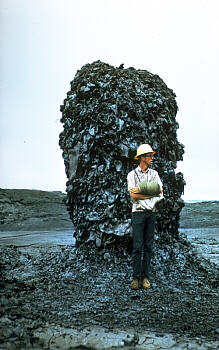hornito

This hornito formed on the surface of a pahoehoe flow during the Mauna Ulu eruption on the east rift zone of Kilauea Volcano, Hawaii. Credit: D. A. Swanson / US Geological Survey.
A hornito is a small rootless spatter cone that forms on the surface of a basaltic lava flow (usually pahoehoe). A hornito develops when lava is forced up through an opening in the cooled surface of a flow and then accumulates around the opening. Typically, hornitos are steep sided and form conspicuous pinnacles or stacks. They are "rootless" because they are fed by lava from the underlying flow instead of from a deeper magma conduit.


